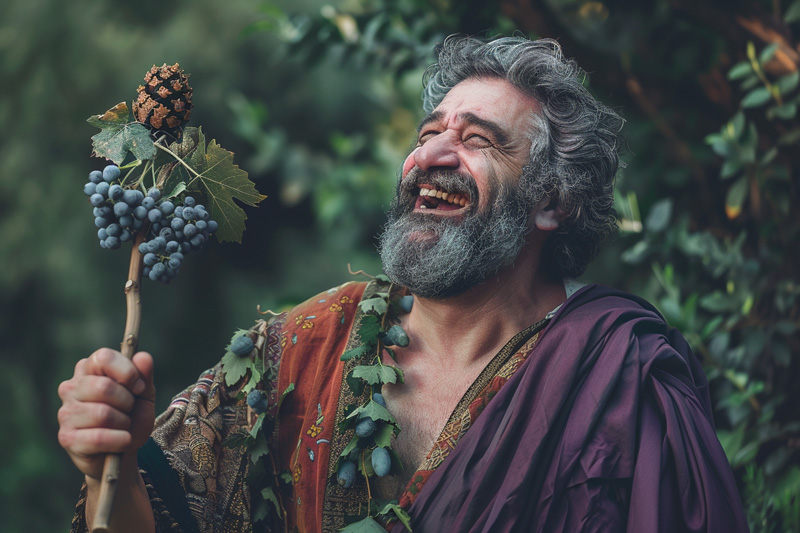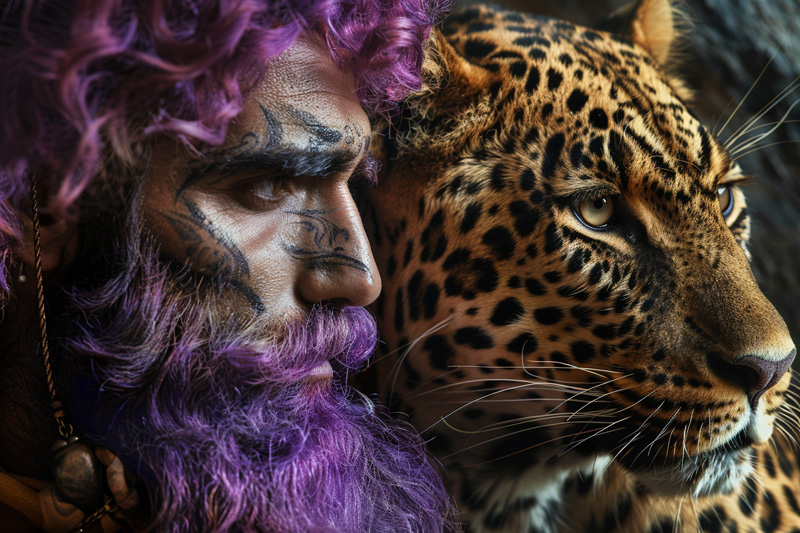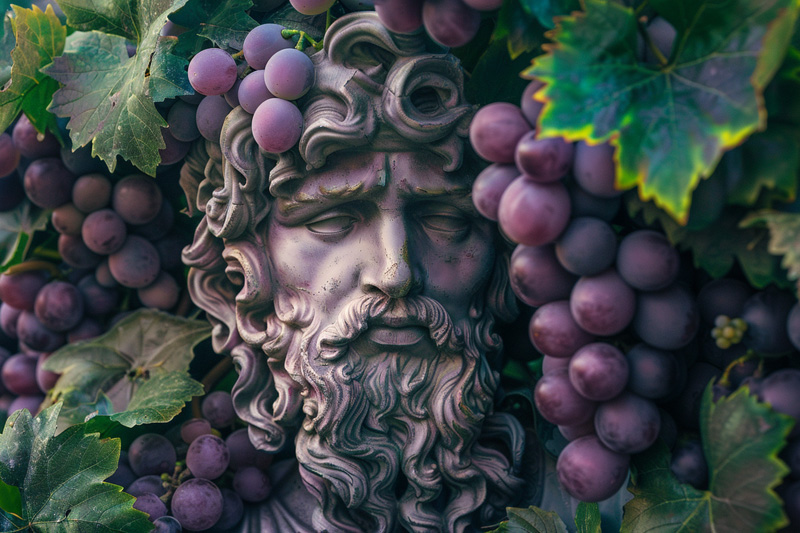KidZone Geography: Greek Mythology
About Dionysus, God of Wine and Festivity
Introduction to Dionysus
Dionysus, one of the twelve Olympian deities in Greek mythology, is the god of wine, festivity, and ecstasy. Known for his dual nature of joy and chaos, Dionysus embodies the vitality of life, creativity, and the transformative power of wine. Often depicted with grapevines and a thyrsus (a staff topped with a pinecone), Dionysus is a central figure in many myths and has a profound impact on Greek culture and religion.

Quick Facts About Dionysus
What is Dionysus the Greek god of?
Dionysus is the Greek god of wine, festivity, ecstasy, and theater. He governs the cultivation of grapevines and the production of wine, as well as the celebratory and chaotic aspects of life.
What are Dionysus's sacred animals?
Dionysus's sacred animals include the leopard, the panther, and the goat. These animals symbolize the wild and untamed aspects of nature, as well as the god's connection to revelry and fertility.
What are Dionysus's symbols?
Dionysus's primary symbols are the thyrsus (a staff topped with a pinecone), the grapevine, and the wine cup. The thyrsus represents his power and connection to nature, the grapevine symbolizes fertility and growth, and the wine cup signifies celebration and intoxication.
Origins and Birth
Birth from Zeus and Semele
Dionysus is the son of Zeus and the mortal princess Semele. Hera, jealous of Semele, tricked her into asking Zeus to reveal his true form. The sight of Zeus's divine form incinerated Semele, but Zeus saved the unborn Dionysus by sewing him into his thigh. Dionysus was later born from Zeus, signifying his divine nature and unique birth.
Dionysus's Role in Greek Mythology

God of Wine and Festivity
Dionysus's primary roles are as the god of wine and festivity. He oversees the cultivation of grapevines and the production of wine, which are central to Greek culture and religious rituals. Dionysus is also associated with festivals, theater, and ecstatic celebrations, embodying the joy and chaos of life.
God of Ecstasy and Transformation
Dionysus is also the god of ecstasy and transformation. He has the power to induce states of ecstatic frenzy and madness, breaking down societal norms and boundaries. His influence can lead to both creative inspiration and chaotic destruction.
Iconography and Symbols

The Thyrsus
The thyrsus, a staff topped with a pinecone, is Dionysus's most recognizable symbol. It represents his power over nature and his ability to induce ecstasy and transformation.
The Grapevine
The grapevine symbolizes fertility, growth, and the cultivation of wine. It is often depicted in association with Dionysus, highlighting his role in agriculture and celebration.
The Wine Cup
The wine cup signifies celebration, intoxication, and the joys of life. It is a common symbol in depictions of Dionysus, emphasizing his connection to festivity and revelry.
Major Myths Involving Dionysus

The Birth and Rise of Dionysus
Dionysus's birth and rise to power are central to his mythology. After his birth from Zeus's thigh, Dionysus was raised by nymphs and satyrs. He traveled the world, spreading the art of viticulture and his cult. Despite opposition from various figures, including King Pentheus of Thebes, Dionysus established his worship and demonstrated his divine power.
The Myth of King Midas
One of the most famous myths involving Dionysus is the story of King Midas. After granting Midas's wish to turn everything he touched into gold, Dionysus later rescinded the gift when it became a curse. This myth highlights Dionysus's dual nature of blessing and curse, as well as his ability to transform.
The Bacchae
The Bacchae, a play by Euripides, explores the conflict between Dionysus and the mortal king Pentheus. Pentheus's refusal to acknowledge Dionysus's divinity leads to his downfall, as he is driven to madness and ultimately killed by his own mother, Agave, in a Bacchic frenzy. This story underscores the god's power and the consequences of denying his worship.
Dionysus's Relationships and Offspring
Marriage to Ariadne
Dionysus's most significant relationship is with Ariadne, the daughter of King Minos of Crete. After being abandoned by Theseus on the island of Naxos, Ariadne was discovered by Dionysus, who fell in love with her and made her his immortal wife.
Divine and Mortal Offspring
Dionysus had several notable offspring, including:
- Priapus: A fertility god associated with gardens and male virility.
- Deianira: A mortal princess who became the wife of the hero Heracles.
Worship and Cult of Dionysus

Temples and Sanctuaries
Dionysus was worshipped throughout ancient Greece, with many temples and sanctuaries dedicated to him. The most famous of these is the Theater of Dionysus in Athens, which hosted performances of dramatic plays during the Dionysia festival. Another significant site is the Sanctuary of Dionysus at Delphi.
Festivals and Rituals
Several festivals celebrated Dionysus's influence over wine, festivity, and theater. The most notable of these is the Dionysia, held annually in Athens. This festival included dramatic performances, processions, and sacrifices in honor of Dionysus. The Anthesteria, another important festival, celebrated the opening of new wine and included various rites and ceremonies.
Dionysus in Art and Literature

Classical Depictions
In classical art, Dionysus is often depicted as a youthful, effeminate figure with a crown of ivy and a thyrsus. He is frequently accompanied by satyrs, maenads, and animals, emphasizing his connection to nature and revelry.
Renaissance and Beyond
During the Renaissance, artists like Caravaggio and Titian drew inspiration from classical depictions of Dionysus, incorporating him into their works. Caravaggio's painting "Bacchus" and Titian's "Bacchanal of the Andrians" highlight the god's dual nature of joy and chaos.
Modern Interpretations
In modern times, Dionysus continues to be a prominent figure in literature, film, and popular culture. He appears in various forms, from comic books and movies to television series and video games. These contemporary portrayals often explore different aspects of his character, from his ecstatic revelry to his transformative power. In the Percy Jackson series, for example, Dionysus is depicted as a complex and somewhat jaded god, reflecting modern interpretations of his myth.
Conclusion
Dionysus remains one of the most dynamic and multifaceted figures in Greek mythology. His role as the god of wine, festivity, ecstasy, and theater, combined with his complex personality and significant myths, make him a fascinating character. As the embodiment of life's joys and chaos, Dionysus's influence extends across the divine and mortal realms. His enduring impact can be seen in the continued fascination with his myths and the artistic representations that keep his legend alive. Through his worship, iconography, and the rich tapestry of stories that surround him, Dionysus exemplifies the vibrancy and complexity of ancient Greek religion and mythology.

